*Wireless Commo Gear Comparison*
Pros & Cons
By Jaden
(22 September 2004)
With all of the means of communications today why not do an analysis of some of them? Weíll cover Ham Radio, CBís, Cellular phones and FRS radios. Letís discuss them a little bit.
- Amateur Radio (my favorite)
Amateur "Ham" Radio comes in many sizes, shapes and forms. There are digital and analog communications. Hams can use FM, AM, USB, LSB, satellites, repeaters, packet (wireless email) Morse code, PSK-31 (wireless chat room format), and voice communications. There are many other modes too. We have telephone interconnects and can actually make phone calls right from the radio. We have bands ranging from HF all the way up into the microwave frequencies. On many bands we can LEGALLY run 1500 watts of power.
Hereís a couple of handheld ham rigs. Both of them have 5 watts of output power.
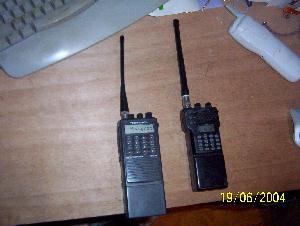
UHF (70cm) 420-450 MHz & VHF (2-meters) 144-148 MHz
Both operate on FM (frequency modulation)
Hereís a 2-meter mobile rig with 45 watts of power.
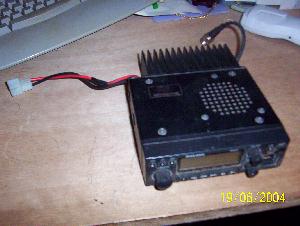
Also operates on FM
Most 2 way FM radios sitting on the squelch threshold have a receiver sensitivity of about .25 uV (microvolts) or better which is pretty good. In the pic above of the hand helds, the one on the rightís sensitivity is .12 uV.
We can talk on simplex (directly from radio to radio) or on half duplex (repeaters). If so inclined we can run full duplex so itís just like talking on a telephone.
Repeaters-
A great asset to hams is a repeater. They are generally located on mountains. A repeater receives my signal on one frequency and simultaneously retransmits it on another frequency to another station. This repeater below is on back up power.
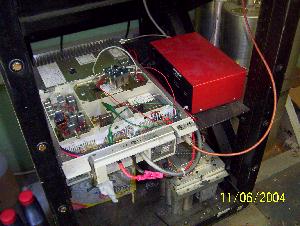
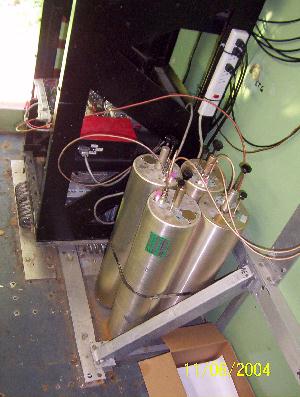
The radio Duplexer
I put this antenna 70í up on this Rohn 25G tower.
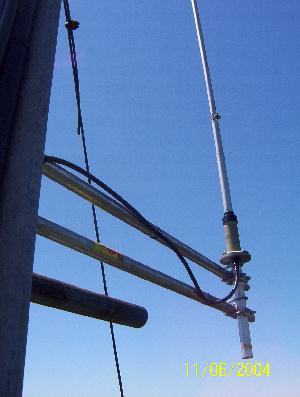
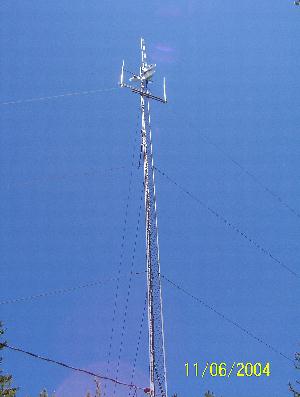
Repeater antenna Itís the one on the left
A good percentage of repeaters have automatic back up power. If the grid power fails the repeater stays on the air. In this state we have a linked system containing some 7 repeaters. I can literally sit here in front of the computer with my 5 watt 2-meter handheld and talk to somebody across the state (200 miles). All 7 repeaters work together and cover about 80% of the state.
If repeaters do fail we can use the HF frequencies and still communicate. We are not dependent on outside resources.
Hams who have the right equipment and have back up power will always have a way to communicate.
CBís have been around for years now. Back in the 70ís & early 80ís everybody and their brother had one. The FCC has since dropped licensing, however there are a few rules still in effect.
CBís operate on 26 & 27 MHz AM (amplitude modulation). They are notorious for only having a short range, usually less than 10 miles and poor audio quality. Some CBís have USB & LSB (upper & lower sideband). Basically all that does is slightly shifts the frequency above or below the carrier frequency. On AM you are allowed to use 4 watts and on sideband 12 watts. There are "kickers" and "boosters" out there to increase power, but they are 100% ILLEGAL! There are reasons for it and itís not "government control". It has to do with RF exposure and safety limits. RF is very dangerous. If you get caught with one by the FCC, I wouldnít want to be YOU! Some people like to get "big" CBís, which have been modified so that they can get more channels. I guess it makes them feel special or something. These "more channels" are actually on the 10-meter amateur frequencies. Again, if you get caught I wouldnít want to be you. Youíre dealing with a bunch of pi$$ed of ham operators & a FEDERAL offense(s).
Hereís a handheld 40 channel CB and a mobile CB -
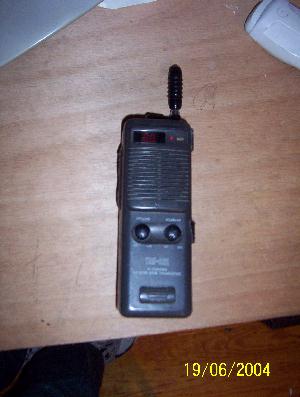
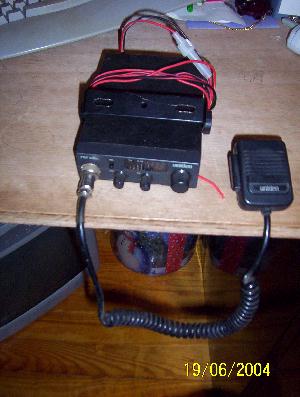
When I checked out the mobile CB on the analyzer I got 4.3 watts on an unmodulated carrier (just keying the mic) and then at 98% modulation (talking in a slightly louder than normal voice) it was pushing a little over 8 watts. With AM the louder you talk, the more power you get. Donít think that by hollering into the mic or buying some power mike youíll get more power. Once the radio is about 100% modulated, thatís all itíll do. By hollering youíre over modulating, which is just going to distort your signal on the other end. The receiver sensitivity in this mobile is 5 uV at the squelch threshold. 5 uV is a lot, but thatís CBís for you. Cheaper CBís donít have a great receiver, which is one reason why their range is so limited. Once that receiver gets less than 5 uV all you get is static. Most CBíers donít know enough to tune their antennas so theyíre driving 4+ watts forward and reflecting about Ĺ of it which means theyíre only getting 2 watts out of their antenna. Tuning also helps reception.
CBís do not have repeater capabilities. It is simplex only. One good thing about CBís are theyíre also not dependent on outside resources in order to operate.
Everybody loves cellular phonesÖwell, everybody except me I guess. Cellular phones rely on outside resources 100%. They operate in the 800-900 MHz range. Newer ones are on even higher frequencies. Analog phones are being phased out. They used to crank 3 watts of power. The new handheld phones only transmit at .6 watts. Thatís just a smidgen over Ĺ of 1 watt. That isnít much especially at that frequency. Thatís why there are cellular towers popping up everywhere. Those frequencies are very line of sight and canít travel great distances with that little bit of power. Therefore, more towers are needed to provide coverage.
Cellular phones require that the equipment on the tower is operable. That means that there needs to be electricity AND there needs to be landline phones connected to it. The cell sites here have generator backup, but what if the phone lines to it are severed? Itís practically useless. If your phone canít reach the next tower, itís junk. Service around here is horrible with all towers functioning. Lose one or two of them and the phones arenít worth a dang thing.
A cellular phone is nothing more than a radio. Itís just a full duplex radio. It allows you to transmit & receive audio simultaneously w/o having to use a push-to-talk button.
- FRS (Family Radio Service)
FRS radios are as popular now are CBís were back in the 70ís & 80ís. It seems everybody has a FRS radio. They are quite handy. Some stores in this area use them. They pick a channel and claim it as theirsÖ.whatever.
Some people think that because they always use channel 10 that itís theirs. Then if they hear somebody else they get ticked off and tell them to get off their channel. Thatís BS. The frequencies are open for ANYBODY to use.
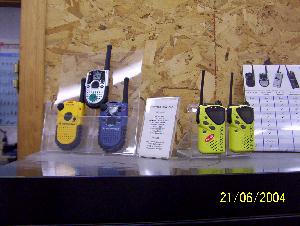
Motorola & Kenwood FRS
FRS radios are simplex only and operate in the UHF-FM frequencies. 12 MHz & 17 MHz above the 70cm ham band actually. They are limited to Ĺ watt of power. They are advertised as "5 mile range" yada yada. Donít believe it. Thatís 5 miles under optimum conditions. Odds are youíll only get 2 miles. All depends on your terrain and obstructions between you and the other party.
Actually, hereís the frequencies. They are narrowband, so if you program them into you scanner and it only accepts wideband, youíre reception will be slightly distorted.
1....................................................... 462.5625
2....................................................... 462.5875
3....................................................... 462.6125
4....................................................... 462.6375
5....................................................... 462.6625
6....................................................... 462.6875
7....................................................... 462.7125
8....................................................... 467.5625
9....................................................... 467.5875
10...................................................... 467.6125
11...................................................... 467.6375
12...................................................... 467.6625
13...................................................... 467.6875
14...................................................... 467.7125
FRS isnít dependent on outside resources. They are a good reliable means of short-range communications. Keep in mind that there are only 14 designated frequencies. If there are a lot of people near you using FRS, the odds are somebody is listening. Even using the voice encryption doesnít mean security. You bought radios with encryption/decryptionÖso canít everybody else.
Having multiple forms of communications is a great idea. Have it all. For your team youíll have a primary form of communication, then have a backup and then a backup to that backup. Itís up to you what you use.
Thereís some facts that you can use to help make comparisons on how different types of radios work and the reliability of them.
Jaden
www.alpharubicon.com
All materials at this site not otherwise credited are Copyright (c) 1996-2004 Trip Williams. All rights reserved. May be reproduced for personal use only. Use of any material contained herein is subject to stated terms or written permission.








